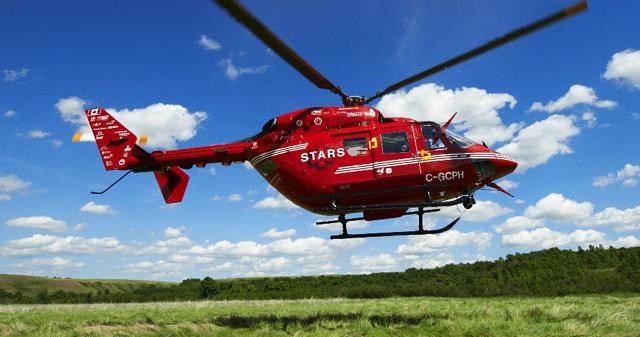The STARS air ambulance service is currently upgrading their fleet of helicopters and are continuing to offer emergency medical response anywhere in Saskatchewan, members of the Weyburn Rotary Club heard in a virtual presentation on Zoom on Thursday.
The presentation was made as the Rotary Club will be doing an internal fundraiser for STARS, as normally they would be holding their golfball drop at this time of year, with proceeds going to STARS. The fundraiser, like most fundraisers in the community, was not held due to COVID restrictions.
Shari Lemon and paramedic Jason Prokopetz did the presentation, explaining what STARS does and how much it costs, and took questions afterward from those watching.
Prokopetz has been a paramedic for 25 years now, and does community education in addition to his duties as a flight team member for STARS at their Regina base.
Lemon noted that STARS is a non-profit emergency medical transport service, and they started in 1985 in Alberta “out of necessity”, with 45,000 missions flown from their six bases since starting up.
In Saskatchewan, they have flown 5,500 missions to over 500 communities in the last eight years, with 884 flown just last year.
“We average eight missions a day across the provinces, or three a day in Saskatchewan,” said Lemon, noting they have flown 136 missions to Weyburn over the past eight years, with 11 missions since the start of 2020. They have flown 189 missions to Estevan, including 15 times so far this year.
The COVID pandemic has had an impact on STARS, and the service is making sure that staff and patients are kept safe, said Prokopetz, who noted they went through a lot of N-95 medical masks at the start of the lockdowns, but have since moved to reusable masks which are far more practical and comfortable to wear.
He said that STARS will fly a COVID patient, or even one who is suspected of having it, taking any precautions necessary.
The dispatching of helicopters to emergencies is coordinated by the Emergency Link Centre in Calgary for all six bases, and they operate a 24-hour seven-days-a-week service. They coordinate any 911 call and consider all of the relevant factors from several sources at the same time, such as the weather and severity of the trauma involved.
For helicopters in Saskatchewan, a new 145 model is based in Saskatoon, while the Regina base has the older DK117, a smaller version of that helicopter. The Regina base is expecting to get a new 145 helicopter towards the end of the year or early in the new year.
Prokopetz explained the difference is the newer helicopters are 10 per cent bigger, 10 per cent faster and can go farther. It has a top speed of 275 km an hour and a range of 650 kilometres, while the older one can go 250 km/h, with a 500-km range, which is 250 kilometres out and 250 back in.
“I sat on one of the new helicopters once. It’s very exciting for me to know it’s coming here to Regina. We’re all kind of excited to see the new helicopters,” said Prokopetz.
The price tag to replace all of the helicopters from the six bases is $138 million. The federal government has contributed $65 million towards this goal, with $13 million each from the Saskatchewan and Alberta provincial governments, plus donations from other organizations and groups. This leaves STARS to raise the remaining $10 million by the end of 2021, when the last of the new helicopters will be delivered.
This fundraising goal is also over and above the ongoing need for operating money, with the two Saskatchewan bases costing $21 million a year to run.
Weyburn’s Dan Cugnet is the chair of the fundraising committee for Saskatchwan for the new helicopters, and former premier Brad Wall is the overall chair for the committee for all six bases.
As a part-time paramedic for a ground EMS service, Prokopetz noted the main differences between a ground ambulance and a STARS helicopter.
He pointed out the helicopters have a ventilator, for example, carry two units of O-negative blood and a blood gas machine so they can do some blood work while they are in the air, and can adjust the ventilator accordingly. They can also do intubation when it’s needed, with video guidance provided by a doctor on the ground, and they can do ultrasounds as well to check for internal injuries of a patient, such as if their spleen is bleeding or if there is liquid build-up in the body’s cavity.
They can transmit all of the data to the trauma team at whichever hospital they are flying to, so the team can take the patient directly into the operating room when they land, he explained.
Each helicopter has a team of four, including two pilots, a paramedic and a nurse. If a pilot is sick and unable to fly, they are unable to go out until a replacement pilot is available to the crew. In addition, STARS has access to an emergency transport physician if the crew thinks one might be needed for a particular patient, such as the need for a surgical procedure right away.
In taking questions from the Rotary members, he was asked how important it will be for Weyburn’s new hospital to have a helipad. His reply is that the closer a helipad can be to a hospital, the better it is for the patient, as currently STARS has to land at the Weyburn airport, and there is a delay to get the patient out to the airport for the helicopter to pick him or her up.
Asked about the costs to the patient for transport by STARS, Prokopetz noted that STARS does not bill the patient, but Sask Health is billed $425 for a patient pickup.




